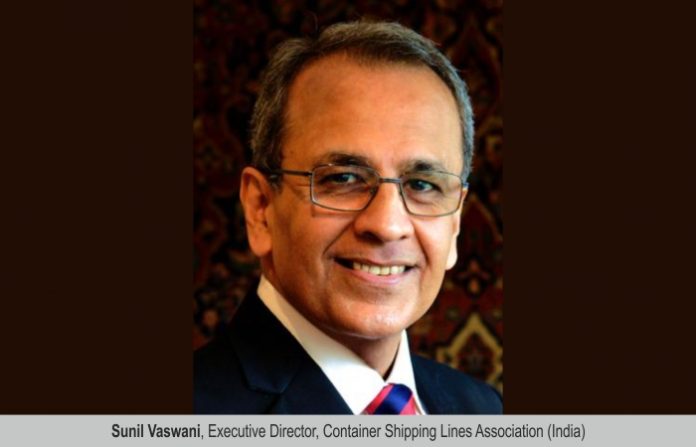With an unprecedented growth in exports volumes, the shipping lines, which earlier used to ship out empty containers from India, had to start repositioning empty containers into the country and move them inland to demand locations at a huge cost. Sunil Vaswani, Executive Director, Container Shipping Lines Association (India) has the details.
Priyanshi Bana
A fter several months of lockdown, the U.S. & Europe went on a buying spree and started importing big time from India, China & the Far East from July 2020 onwards. At the same time, Indian imports dropped due to low consumer demand locally and certain restrictions on imports from China. This created a major equipment imbalance as export demand for containers far outweighed the import supply. The pandemic thus distorted the demand & supply situation. The Indian trade which was always dominated by imports saw a sudden surge in exports and a drastic reduction in imports, something that no one had really anticipated. During the third quarter of 2020 for instance, India’s exports in terms of volumes grew by 24 per cent while its imports reduced by 28 per cent compared to the same period in 2019. The excess of exports over imports continued thereafter too. As a result, the shipping lines, which earlier used to ship out empty containers from India, had to start repositioning empty containers into the country and move them inland to demand locations at a huge cost.
This distortion in demand & supply, with its resultant impact on costs & rates, did not happen just in the case of India but in the case of the rest of the world too. Besides, this was unique not just to container shipping but applied to airfreight as well. In fact, unlike in the case of sailings of container shipping lines, the number of international flights plunged due to the virus & air travel restrictions, thereby pushing some of the air freight business like i-phones, leather goods, etc., to sea freight, thus putting additional pressure on container shipping.
Congestion at transhipment ports like Colombo & Singapore and in some of the major ports in China, Europe and the key gateway ports on the east & the west coasts of the U.S. further aggravated the situation by increasing the turnaround time of vessels & containers. Ports like Shanghai & Shenzhen for instance have been experiencing berthing delays of 5 to 7 days. Similarly, Hamburg, Antwerp & Felixstowe have been having berthing delays of 4 to 7 days, Los Angeles & Long Beach – 8 / 10 days, Vancouver – 7 days & New York – 2 to 6 days. Hundreds of ships around the world have been waiting for a week or even longer before they can berth. Currently about 300 vessels are waiting to berth at approximately 100 ports across the globe. In view of the increased volumes coupled with COVID protocols and labour & trailer shortages, the terminals internationally have been struggling to keep the momentum going. North America for instance, has continued to face a 40 pct equipment imbalance.
In other words, out of every 100 containers entering North America, just 40 move out. Presently, about 55 pct of the container fleet is sitting either at various ports or on water, as against the normal average of just about 30 pct. All this has resulted in the slower turnaround of boxes. The issue thus has more to do with the limitations at terminals globally which has resulted in the slower turnaround of ships & containers & impacted their eventual availability at the required locations. Despite all this, the shipping lines, on their part, have been continuing to reposition empty containers into India at a huge cost, to help meet the export demand. Besides, all available vessels have already been deployed with the idle fleet being just 0.8 pct which comprises essentially of vessels undergoing repairs & maintenance. All available tonnage in the charter market too has been on-hired by the lines at exorbitantly high charter hire levels which have increased five-fold as compared to last year. It must also be noted that any increases in the freight rates have happened not just in the case of India but in the case of other countries too. In fact, it’s happened even more so in the cases of China & S.E. Asia. Also, the shipping lines have always transparently put up their charges in the public domain. As a matter of fact, they are the only ones to display their charges on their respective websites.
It is also pertinent to note that between 2020 & 2021, the shipping lines introduced additional services which increased capacities ex India to the tune of 11,000 TEUs a week to the U.S., 2,000 TEUs a week to Europe, 6,500 TEUs a week to West Africa & 14,000 TEUs a week to the Far East. Hence, all efforts have been made by the lines to meet the demand which in turn has helped Indian exports to grow, with the first quarter of this financial year registering a growth of 16 pct in exports over the same period of the normal year – 2019/20. Further, MSC has revised the rotation of its existing Indus Express & Indusa Services and is also launching a new Indus 2 Service from Aug 30, 2021 which should improve its service levels & enhance its capacity further from India to the U.S. East Coast & Med ports.Besides, orders for 437 new ships have already been placed by the various shipping lines with the shipyards. These ships should start joining the existing fleet from mid-2022 onwards. That should further help in increasing capacities to meet the demand.













